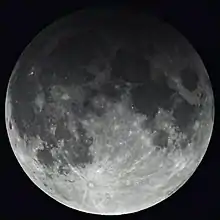November 2020 lunar eclipse
A penumbral lunar eclipse took place on 30 November 2020. A penumbral lunar eclipse occurs at full moon when the Moon passes through Earth's penumbral shadow.
| Penumbral eclipse | |||||||||
 Minneapolis, MN at 9:24 UT | |||||||||
| Date | 30 November 2020 | ||||||||
|---|---|---|---|---|---|---|---|---|---|
| Gamma | −1.1309 | ||||||||
| Magnitude | 0.8285 | ||||||||
| Saros cycle | 116 (58 of 73) | ||||||||
| Penumbral | 260 minutes, 59 seconds | ||||||||
| |||||||||
The penumbra caused a subtle dimming on the lunar surface, which was only visible to the naked eye when 82.85% of the Moon's diameter had immersed into Earth's penumbral shadow.[1]
Visibility
It was visible after sunset from east Asia and Australia, and before dawn in North and South America.
  |
 Visibility map |
Related eclipses
Eclipses of 2020
- A penumbral lunar eclipse on 10 January.
- A penumbral lunar eclipse on 5 June.
- An annular solar eclipse on 21 June.
- A penumbral lunar eclipse on 5 July.
- A penumbral lunar eclipse on 30 November.
- A total solar eclipse on 14 December.
Lunar year series
| Lunar eclipse series sets from 2020–2023 | ||||||||
|---|---|---|---|---|---|---|---|---|
| Descending node | Ascending node | |||||||
| Saros | Date | Type Viewing |
Gamma | Saros | Date Viewing |
Type Chart |
Gamma | |
111 |
2020 Jun 05 |
Penumbral |
1.24063 | 116 |
2020 Nov 30 |
Penumbral |
−1.13094 | |
121 |
2021 May 26 |
Total |
0.47741 | 126_(cropped).jpg.webp) |
2021 Nov 19 |
Partial |
−0.45525 | |
131_(cropped).jpg.webp) |
2022 May 16 |
Total |
−0.25324 | 136 |
2022 Nov 08 |
Total |
0.25703 | |
141 |
2023 May 05 |
Penumbral |
−1.03495 | 146 | 2023 Oct 28 |
Partial |
0.94716 | |
| Last set | 2020 Jul 05 | Last set | 2020 Jan 10 | |||||
| Next set | 2024 Mar 25 | Next set | 2024 Sep 18 | |||||
Saros series
It is part of Saros cycle 116.
Half-Saros cycle
A lunar eclipse will be preceded and followed by solar eclipses by 9 years and 5.5 days (a half saros).[2] This lunar eclipse is related to two partial solar eclipses of Solar Saros 123.
| 25 November 2011 | 5 December 2029 |
|---|---|
 |
 |
Tritos series
- Preceded: Lunar eclipse of December 31, 2009
- Followed: Lunar eclipse of October 30, 2031
Tzolkinex
- Preceded: Lunar eclipse of October 18, 2013
- Followed: Lunar eclipse of January 12, 2028
References
- H. Mucke, J. Meeus (1992). Canon of Lunar Eclipses -2002 to +2526 (3rd ed.). Astronomisches Büro Wien. p. V.
- Mathematical Astronomy Morsels, Jean Meeus, p.110, Chapter 18, The half-saros
External links
- Saros cycle 116
- 2020 Nov 30 chart: Eclipse Predictions by Fred Espenak, NASA/GSFC
Wikimedia Commons has media related to Lunar eclipse of 2020 November 30.
This article is issued from Wikipedia. The text is licensed under Creative Commons - Attribution - Sharealike. Additional terms may apply for the media files.




